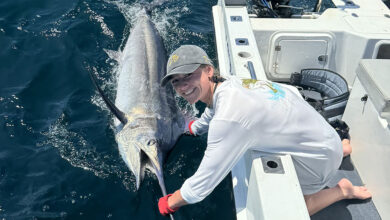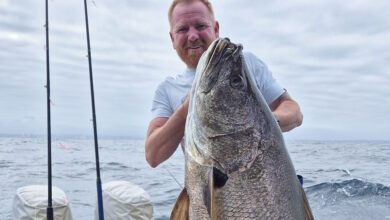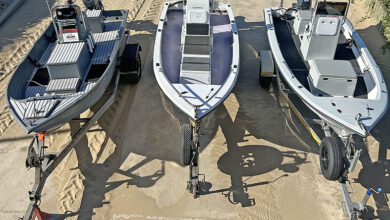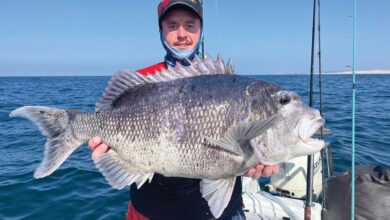HOW TO TEMPT A TIGER
Lessons from marlin masters turned tiger tamers
By Andre Maree and Berno Meyer
(Originally published in the January 2025 issue of SKI-BOAT magazine)
It may seem that there’s not much linking billfish and tigerfish other than the fact that they’re both species of fish found in South African waters, but many South African billfish anglers also eagerly venture to inland venues like Jozini/Pongolapoort Dam to catch these tough-fighting smaller, sharp-toothed, stripey species of fish.
Andre Maree and Berno Meyer are two such anglers. These cousins earned their billfish stripes in the 1970s, catching their fair share of marlin off Sodwana on their boat fm Charlie, and although they still target marlin sometimes, in recent years they have particularly enjoyed targeting the tigers of Jozini.
Berno and Andre have introduced their sons to the sport too, and the two families did particularly well at the 2024 Tigerfish Bonanza. Erwin Bursik persuaded them to share some of their sectrets to tempting tigers to bite…
THERE is a certain feeling of inadequacy that overcomes a person when the leaderboard at the competition you’re fishing at keeps ticking over, but no matter how hard you try, your boat is not able to make it onto that leaderboard.
An array of questions fog one’s mind: What’s the right place, right bait, right trace?
Adding to the pressure is the fact that, in this new digital age, the crew is able to keep tabs on the minute by minute additions to that leaderboard, and they’re quick to tell the skipper he’s not keeping up. This was very much the case during the recent Tigerfish Bonanza held at Jozini/Pongolapoort Dam.
This year those of us aboard fm Charlie and Obsession were acutely aware of that leaderboard, but, to our delight, we were right up there and very much “in the prizes”.

As cousins who both farm in the Pongola/Piet Retief area and who are both ardent anglers, the two of us have fished together for decades.
We started off frequenting Sodwana Bay when we acquired our original fm Charlie in the mid-1970s. We were very much part of the group of dedicated billfishermen who, during the late 1970s and early 1980s, set out to prove there was a billfishery off Sodwana that could compete with the one off the central Moçambique coast.
We clearly got something right, as the flags on fm Charlie showed when we returned to the beach.
We were never “bounty hunters”, though, generally preferring to fish simply for our own pleasure rather than competing in the events held annually off Sodwana Bay. We did, however, compete in those occasionally, and fm Charlie won the Billfish 15 000 in 1998 with Andre skippering and Berno as crew. Berno also won a comp on Lady Ace, so the two of us did scoop up a few prizes. In those days the biggest fish won the comp, and there was one occasion when we had the most points but didn’t win because we didn’t have the biggest fish.
Since the early ’90s we’ve been fishing in Bazaruto, always on the hunt for that elusive grander. However, despite our efforts, we’ve yet to land a fish weighing 900 lb or more. We have hooked some impressive catches that might have reached that mark, but haven’t managed to bring them to the boat.
We also explored a few other areas in Moçambique – Berno has fished at Inhaca, and together we also explored the waters around Canda Island when our children were younger. That was a fantastic experience, as there’s an abundance of gamefish in that area and the kids quickly picked up fishing skills.

While we’ve continued to fish at Sodwana, we stepped away from those competitions for a while. Our sons are older now, and we still target marlin there whenever time allows, but our passion for fishing extends beyond just billfish. We enjoy pursuing all species, both in saltwater and freshwater, and targeting the tigers at Jozini is one of our favourite pastimes.
We’ve got pretty good at that too, and at the 2024 Tigerfish Bonanza, fm Charlie took the prize for top boat with four tigerfish (2 500 points), including the fourth biggest tiger of 69cm. Obsession, skippered by Berno, caught the second biggest fish which measured 69.5cm and the tenth biggest which measured 65.5cm.
I guess the Maree & Meyer “old boys” still know a few tricks!
Erwin Bursik has stayed in touch with us over all these decades, and he twisted our arms at this year’s Tigerfish Bonanza, urging us to pass on the knowledge we – and these days our sons – have gained on how to catch tigerfish in our home waters of Jozini Dam.
Both of us have always been intensely single minded with regard to our fishing exploits, setting our own gameplan and then sticking to it and, above all, never stopping working to achieve our goals. We don’t believe in the “follow my leader” plan and spend as much time as we can in the area where we believe fish will be holding – be they marlin or tigerfish.
Luck is a major factor in angling, and whether one is fishing the OET or Billfish 15 000 with close on 100 boats ploughing up the waters off Sodwana Bay, or the Tigerfish Bonanza on Jozini Dam with 200 boats racing around, temping a fish to strike is the first goal. Thereafter tackle and rodmanship play their role and you, the angler, are totally responsible for your part.
With this in mind, we will happily share our knowledge of where to look for tigerfish and the tackle and bait we use. Hopefully that will result in you getting a big tigerfish to strike and hookup, and in you bringing one of those magnificent fish to the net.
So, let’s get down to business!
TYPE OF ROD
While the type of rod is not as important here as it is when you’re deep sea angling, and largely any light tackle rod will suffice, we recommend 6- to 8 foot fast action rods that have a “backbone” to exert pressure on what can be a fast and hard fighting fish. Tigers know the tricks of using underwater structures and reed banks to tangle up one’s line, so you need to bully them way from that.
TYPE OF REEL AND LINE
The open-faced spinning reels in the 4 000 to 6 000 class are what we prefer. It’s important to ensure that the drag – from just off freespool to full strike – is extremely smooth, thus ensuring an even connection between rod and fish during the aerobatics and head shaking that’s so prevalent with this species.
We use braid line in 15- to 30 lb breaking strain, and a fluorocarbon leader.

TRACE CONFIGURATIONS
This is the most lengthily deliberated of all aspects of targeting tigerfish.
The tiger’s teeth are legendary and so is the bony structure of its mouth and throat. Added to this, the tiger hits hard and fast with little finesse. This results in the well accepted adage that, whether you’re fishing in fresh- or saltwater, tigerfish are the hardest gamefish to get to the boat. If you actually get a hookup, your tackle then has to weather their speed and acrobatics as they fight for their freedom.
The diagram above shows the trace setup we use as well as the style of float we have found most effective. We use fluorocarbon leader in the 20- to 30 lb class attached to 30cm of Black Tiger Wire (stainless steel leader) in 30- 40 lb breaking strain.
The hooks we usually use are Penetrator J-hooks in 4/0 size. We use either one or two hooks depending on the size of the livebait we use.
BAIT VERSUS LURES
There is no doubt that fishing spinners and trolling certain lures produces fish, but we find those mainly bring in the smaller tigers, and spinning while on anchor with livebaits set for the big mamas doesn’t seem to entice the big fish to bite.
For this reason we generally don’t mess around with this style of fishing, as Murphy’s law states that when you are doing this and a big strike happens, you’ll be playing pick up sticks and will lose the strike you have been eagerly awaiting.
Some anglers believe that using whole sardines, redeyes, chicken livers or hearts can encourage big fish in the area to strike. This is another school of thought we generally don’t subscribe to. It’s a case of an impala temping you when you are after a buffalo.
At Jozini when we’ve used spinners, chicken livers, hearts and sardines, we’ve typically only caught smaller fish. Although we usually stick to bait, we have, however, caught some tigerfish while trolling CD 9 Rapalas.
We are fortunate that Berno lives in Pongola and is able to supply us with fresh livebait, and for this we like bream larger than 80mm. Alternatively we use dead bream with cuts made in the body.
We only use chicken hearts, livers and sardines if we’re targeting smaller tigers.
WHEN TO FISH
Tigers don’t like the north-easterly winds, and certainly we tend to have more success when the westerly blows. The old adage of “West is best and east is worst” seems to hold true.
During normal conditions, when there are not 200 boats running around the dam, the early mornings produce the best results.
WHERE TO FISH
From early spring until the first significant rains, the best fishing action can be found at the point where the river enters the dam – depending on the dam’s water level. Upriver towards the bridge and up towards Royal Swazi are also good.
During the summer and autumn months, particularly April and May, the western shores are prime fishing location and the eastern side tends to have less fish activity.
WHERE TO ANCHOR
We prefer to anchor close to the bank and reed clusters in about 3–8 metres of water along the old river channel. Make sure you keep a fair distance from any structure to avoid your fishing line snagging frequently.
Always deploy two anchors – one in the bow and one in the stern, especially if there is a lot of wind. This is vital!
On a calm day, drifting in the suggested areas often produces good fish.
How long should you stay in one area? Our thinking is this: give it an hour, and if there’s no action, move on.
The above is good advice for fishing in the hotter months. In the colder months we fish much deeper – generally depths up to 20 metres.
HOW TO FISH
When you’re fishing with light line and a single hook using livebait, it’s important to feed the tigerfish for ten to 15 seconds before striking. However, this method can often lead to you getting snagged on structure when you strike. This technique also increases the likelihood of the tigerfish swallowing the hook which can result in a higher mortality rate for the fish.
When using a float, strike as soon as you see a bite, and consider using more than one hook.
As I’ve said, tigerfish are a challenge to catch, especially the big fish, but as the years go by, it seems more and bigger fish are being caught than there were in previous years. The regulation requiring all tigers caught in Jozini to be released does seem to be working, and we look forward to witnessing this trend continuing into the future.
A day spent targeting tigers on Jozini is a wonderful experience, so we hope these tips improve your chances of landing some.






